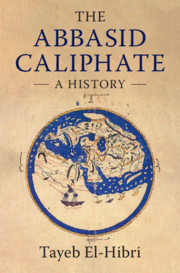Book contents
- The Abbasid Caliphate
- The Abbasid Caliphate
- Copyright page
- Dedication
- Contents
- Figures
- Maps
- Acknowledgments
- Note on Transliteration
- Chronology
- Abbreviations
- Genealogical Chart of the Caliphs
- Maps
- 1 Introduction
- 2 From Revolution to Foundations (750–775)
- 3 The Golden Age of the Abbasid Caliphate (775–833)
- 4 From Triumph to Tribulation (833–990)
- 5 The Caliphate as a Religious Authority (990–1225)
- 6 The Twilight of the Abbasid Caliphate (1225–1258)
- 7 Conclusion
- Appendix: The Abbasid Caliphs
- Glossary
- Bibliography
- Index
- Plate Section
5 - The Caliphate as a Religious Authority (990–1225)
Published online by Cambridge University Press: 28 April 2021
- The Abbasid Caliphate
- The Abbasid Caliphate
- Copyright page
- Dedication
- Contents
- Figures
- Maps
- Acknowledgments
- Note on Transliteration
- Chronology
- Abbreviations
- Genealogical Chart of the Caliphs
- Maps
- 1 Introduction
- 2 From Revolution to Foundations (750–775)
- 3 The Golden Age of the Abbasid Caliphate (775–833)
- 4 From Triumph to Tribulation (833–990)
- 5 The Caliphate as a Religious Authority (990–1225)
- 6 The Twilight of the Abbasid Caliphate (1225–1258)
- 7 Conclusion
- Appendix: The Abbasid Caliphs
- Glossary
- Bibliography
- Index
- Plate Section
Summary
The reign of the caliph al-Qadir signals the rediscovery of Abbasid religious authority on the basis of new terms. The Buyid--Abbasid rivalry with the Fatimids of Egypt provides an opportunity for shared interests between the caliph and the Buyids. The drafting of the Qadiri Creed in Baghdad outlines elements of Sunni belief that become official doctrine and provide a rebuttal of Fatimid ideology. The rise in the caliph's position as a religious arbiter, and the alignment of al-Qadir and al-Qa'im with a prolific class of 'ulama and jurists, such as al-Mawardi, attracts distant support from the newly rising Ghaznavids and the Seljuks. The Seljuk entry to Baghdad in 1055 brings about a new formula of affinity between caliphs and sultans. Continued Abbasid attempts for a reassertion of authority finally succeed in the caliphate of al-Nasir, who is helped by an international situation that ends the last vestiges of Seljuk political influence. The Mongols, under Genghis Khan, dominate the Iranian world but stop short of invading Baghdad. Al-Nasir's interest in Sufism and the Futuwwa movement incorporates a new dimension in Abbasid religious authority, while the rising tide of conquests against the Crusades further strengthens the caliphate's image as a central religious authority in the Islamic world.
Keywords
- Type
- Chapter
- Information
- The Abbasid CaliphateA History, pp. 193 - 245Publisher: Cambridge University PressPrint publication year: 2021

